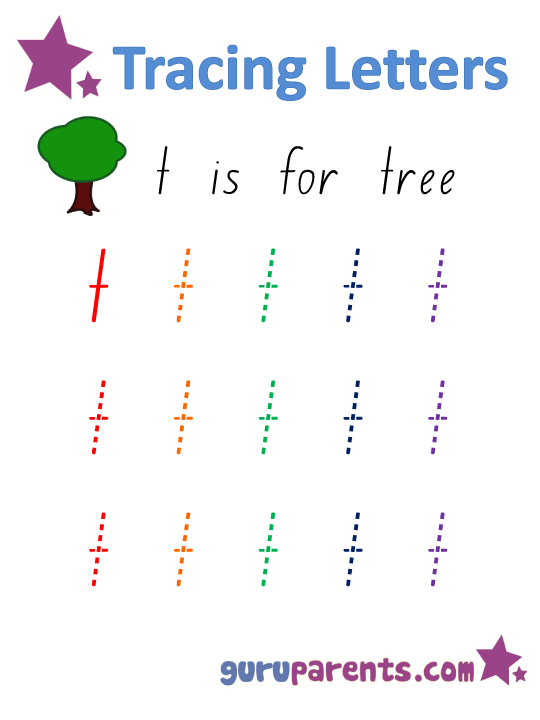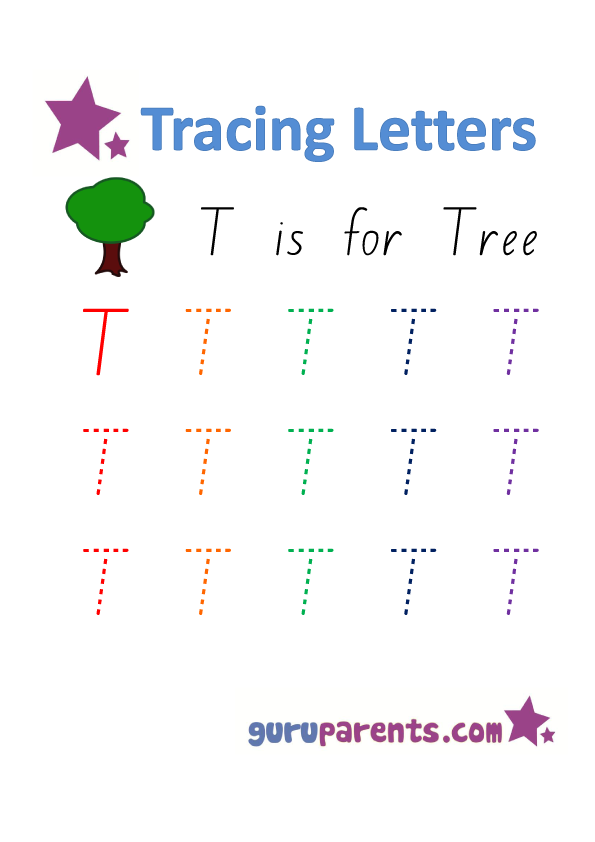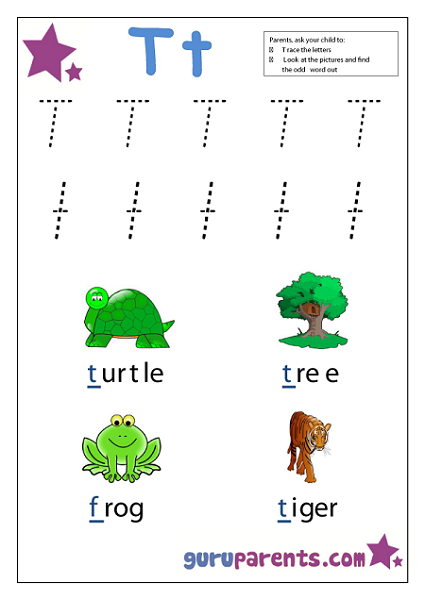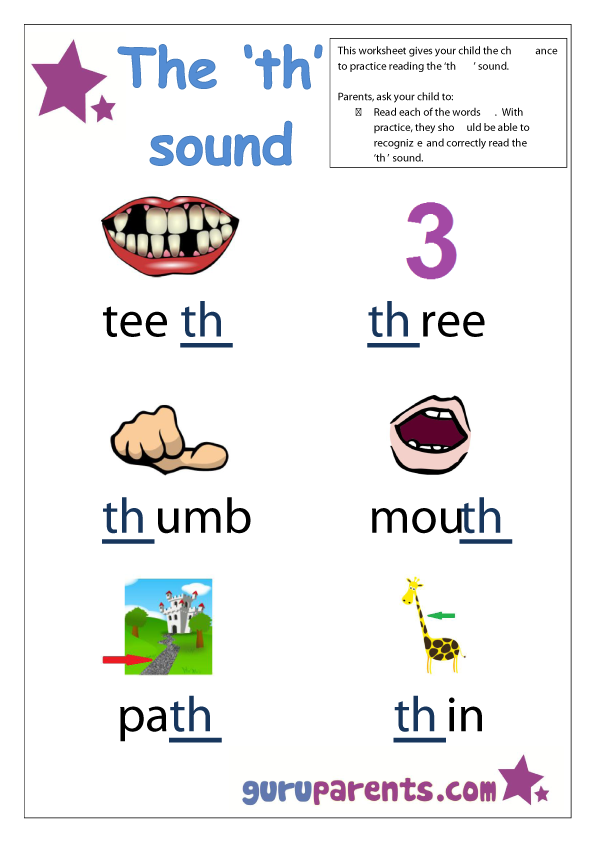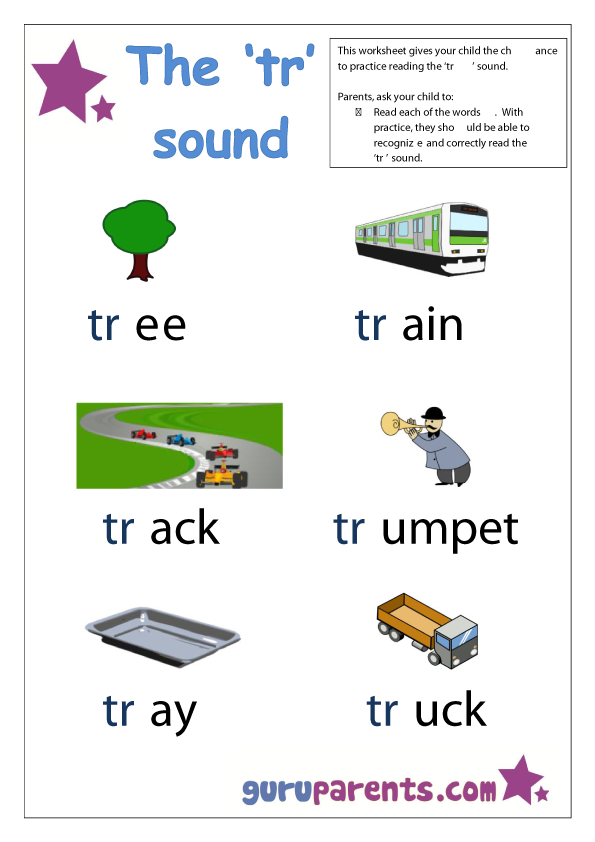Worksheets
Click here to download all Letter T Worksheets
In a nutshell
The letter ‘t’ is one of the most important in English. After ‘e’ it is the most commonly used letter – almost one out of every ten letters in English usage is a ‘t’. And, in forming the ‘th’ sound, it is involved in one of English’s most important, most used – and most difficult – letter combinations.
Letter t songs
This is a wonderful introduction to the letter t from Sesame Street:
This Guruparents video features the ‘th’ sound:
Difficulty in saying ‘th’ for children
Many languages do not have a ‘th’ sound and non-native speakers often find the tongue position very hard to form. But even native speakers can find it hard. Along with ‘r’ and ‘v’, ‘th’ is the hardest sound for children to learn – and often one of the last sounds they acquire. This page from Speech Pathology Australia contains a number of fact sheets, including ones detailing the ages that children typically learn sounds.
If you would like to check if your child’s progress is normal, or to seek assistance, here are links to some professional speech pathology associations:
USA: www.asha.org
UK: www.rcslt.org
Australia: www.speechpathologyaustralia.org.au
Difficulty in saying ‘th’ for non-native speakers
Here is a funny ad from Germany, encouraging people to learn better English:
If English is not your native language, this video takes you through exactly how your tongue and mouth need to be moved to make the sound. (As you will see in the video ‘th’ actually makes two different sounds – a voiced sound in words such as ‘that’ and ‘those’ and an unvoiced sound in words such as ‘think’ and ‘thick’):
Dialects of English
One of the joys of English is the wide varieties of dialects and accents to be found among native speakers. The ‘t’ and ‘th’ sounds are pronounced in a variety of different ways around the English speaking world. For example, in the upper class English of England, ‘water’ is pronounced as it is spelled, but in cockney English it sounds more like ‘wah-uh’ – as if the ‘t’ has almost vanished – and in many parts of America the ‘t’ sound is replaced with a ‘d’ sound.
The ‘th’ sound is more consistent, yet in parts of Ireland you will hear it said as ‘t’ – making the word ‘three’ sound as though it were ‘tree’. And in Yorkshire, in the north of England, the word ‘the’ is often almost abandoned completely – with only the faintest ‘t’ sound heard instead. Here is a clip of an English comedian, Michael McIntyre, who is not from Yorkshire, having some fun with the Yorkshire accent in front of a Yorkshire audience:
‘I Spy’ words
‘I spy with my little eye, something beginning with…’ is a great game to play to reinforce the sound that a letter makes and it can be a fun game to kill some time – for example on a long car trip.
Here is a selection of short words starting with ‘t’ for you to use:
toys, tongue, table, tap, truck, train, tomato, toast, toes, tree, tail, tape, tea, tie, tin, tub, table, taco, tag, tank, taxi, t-shirt, teeth, toad, tofu, town, tram, tube, tuna, twig, twins, tire.
The Letter T Worksheets
Tracing Letters – T is for Tree
This letter t worksheet gives your child lots of opportunities to practice writing capital T.
Tracing Letters – t is for tree
This letter t worksheet focuses on the lower case letter t.
This letter t worksheet gives your child an introduction to the sound that ‘t’ makes, and also allows them to practice writing the capital and lower case letter t.
The ‘th’ sound is one of the most valuable to learn in the whole language – here are six examples for your child to practice with.
This letter t worksheet provides an introduction to ‘tr’, a letter combination seen in numerous words, such as ‘try’, ‘train’ and ‘tree’.
<<Previous letterNext letter>>
Back to preschool letter worksheets from letter t worksheets

